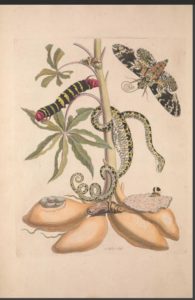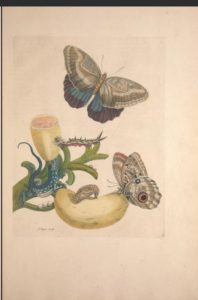In celebration of Women’s History Month, March Object of the Day posts highlight women designers in the collection.
Maria Sibylla Merian (German, 1647-1717) was a remarkable naturalist, famous for her expertise in entomology and the art and details of her scientific illustrations. From a young age, Merian was taught how to draw and enthusiastically explored the insect world. After her marriage to Johann Andreas Graff (German, 1636-1701) in 1665, she created a series of watercolor engravings of flowers. No longer married by 1699 and well known for her studies on insects and her artistry, Merian traveled with her daughter Dorothea Maria for a five-year expedition to Suriname, located on the northeastern coast of South America.
The Cooper Hewitt, Smithsonian Design Library holds a very rare copy of one of Merian’s works titled Over de voortteeling en wonderbaerlyke veranderingen der Surinaamsche insecten …, one of a few volumes published of her discoveries and studies during her sponsored trip to Suriname.

Plate V, Verandering Der Surinaamsche Insecten
The beautiful details and color are still vibrant today. Each image is very precisely rendered and testify to Merian’s close and illuminating observations of the flora and fauna.

Plate XXIII, Verandering Der Surinaamsche Insecten
Merian studied the life cycle of 186 insect species, documenting their metamorphosis and challenging accepted— and often negative—beliefs about insects with her empirical research. Her scholarship on butterflies is still the standard for identification used today. Her works have been a source of inspiration for the scientific community and for designers, who have created stamps, jewelry, and more based on her illustrations. Her illustrations of butterflies have been on display frequently at Cooper Hewitt and hopefully Merian’s work will continue to inspire future generations.
Nilda Lopez is the Library Technician at Cooper Hewitt, Smithsonian Design Library.
